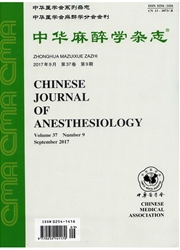

 中文摘要:
中文摘要:
目的大鼠鞘内注射含人前脑啡肽原基因(HPPE)单纯疱疹病毒Ⅰ型(HSV-Ⅰ)扩增子载体的镇痛效应。方法60只纯种雄性SD大鼠,采用改良Yaksh法进行鞘内置管后,随机分为生理盐水组(NS组,n=18)、空白载体pHSVIRES-LacZ组(SHZ组,n=18)、重组HSV-Ⅰ扩增子载体pHSVIRES-HPPE-LacZ组(SHPZ组,n=24),大鼠鞘内分别注射生理盐水、SHZ、SHPZ,1周后分别从NS组、SHZ组和SHPZ组中取11只、11只、16只大鼠,取脊髓组织,用X-gal染色原位法测定LacZ的表达,用RT-PCR方法测定HPPE mRNA的表达,用放免法测定L-脑啡肽(L-EK)含量,并测定注射SHPZ后3d、1周、2周、3周、4周、5周时热痛阈(用后爪缩腿潜伏期表示)。结果在体转染大鼠中枢神经细胞,外源脑啡肽基因能有效表达。与基础值比较,SHPZ组注射SHPZ后1~4周时热痛阈升高,于注射SHPZ后3周时达到高峰(P〈0.05);与NS组及SHZ组比较,SHPZ组于注射SHPZ后1~4周时热痛阈升高(P〈0.05),注射SHPZ后1周时脊髓组织L-EK含量升高。结论大鼠鞘内注射SHPZ有明显的镇痛效应。
 英文摘要:
英文摘要:
Objective To determine the analgesia and the expression of LacZ and HPPE mRNA in the spinal neurons after intrathecal (IT) administration of HSV-1 amplicon vector-mediated HPPE gene.Methods Male SD rats weighing 280-320 g were used in this study. A microcatheter was placed in the subarachnoid space according to Yaksh . The tip of the microcatheter was positioned at lumbar region of spinal cord. Sixty rots in which IT catheter was successfully placed without any functional disturbances were randomly divided into 3 groups : group Ⅰ pHSVIRES-HPPE-LacZ (SHPZ, n = 24) ; group Ⅱ pHSVIRES-LacZ (SHZ, n = 18) and group Ⅲ normal saline (NS, n = 18). One week after IT administration 16 animals in group Ⅰ and 11 animals each in group Ⅱ and Ⅲwere killed and lumbar segment of spinal cord was removed for determination of expression of LacZ (X-gal staining) and HPPE mRNA (RT-PCR) and L-enkephalin content (radioimmunoassay) in spinal cord. The paw withdrawal latency (PWL) to radiant heat was measured once a week for 5 weeks after IT administration. Results After IT administration of SHPZ the expression of HPPE mRNA in the spinal cord was detected and PWL to radiant heat was significantly prolonged as compared to the baseline value. Analgesia started from 1st week and peaked at the 3rd week. PWL returned to baseline level at the 5th week. Conclusion Intrathecal administration of SHPZ produces significant analgesic effect.
 同期刊论文项目
同期刊论文项目
 同项目期刊论文
同项目期刊论文
 期刊信息
期刊信息
